If you trade cryptocurrency often, you probably know that there is a lot of useful and perhaps crucial data that would take too long to analyze manually. This is where backtesting comes into play. It is a great tool to speed up and simplify your analyses.
This article will explain the concepts of backtesting and forward testing, guide you through backtesting on a trading bot called Cryptohopper, and help you understand whether backtesting really gives better trading results.

What is Backtesting?
Backtesting is defined as executing a trading strategy across historical market data before activating it in the future market. The results are analyzed for trading signals and profitability, and the strategy is then kept for real trades or discarded. This data can be mapped manually, but it is mostly done by offline or online trading software because of greater speed and efficiency.
Backtesting software can run far into the past and read data from more than 10 years back. This is a great feature by itself, because you have a lot of testing ground for a variety of tactics and strategies without investing your money or having to use simulations.
What is Forward Testing?
Yet, backtesting is not perfect and there is always the risk of “curve fitting” or overoptimizing and falling for false conclusions and losing in the market. This is why forward testing should also be done to complement it. Forward testing is basically a trading simulation of your strategy in a real market, to see how it would perform without investing money yet. This is why it is called paper trading. Your results are documented and noted down as if you traded.
This is a good way to put your strategy to the test. Just remember that you always need to avoid logical fallacies when analyzing, which is one of the top skills needed for profitable trading.
How To Do Trading Strategy Backtesting on Cryptohopper?
Cryptohopper backtests a combination of your strategy and other configuration parameters. It is an automated trading bot with a TrustPilot score of 4/5 and a verified status. You can learn more about it in a Cryptohopper review by Scammerwatch.
To start backtesting, go to your Cryptohopper dashboard and select Backtesting from the left-hand menu. Select your currency and then open the “strategy” drop-down menu. Here you can see a list of your custom strategies, as well as Cryptohopper’s built-in strategies. Under this are the parameters for stop-loss, ”take profit at”, and so on. If you want to fill your current configuration automatically, click “load existing config” at the top. The last step is to enter the period in which you want to perform the test; don’t forget that longer periods mean longer waiting times.
If you like the results, you can click “deploy this configuration” and apply them instantly to your current strategy. Finally, all your tests appear in your backtest history, where you can take the time to analyze and learn from the tests you have done.
Does Backtesting Make You a Better Trader?
Yes and no. No, because backtesting does not increase your trading skill per se, and it does not guarantee more successful trades. To get better at trading, you need to practice active trading as much as you can. Each currency behaves differently and you can start by reading day trading online guides for Bitcoin.
However, there are a lot of benefits of backtesting which can indirectly make you – better. For example, when you find positive results in a strategy, this means that it is more likely to work in the future. This boosts your trading confidence in general and may help you make better moves intuitively. Secondly, backtesting improves your mindset psychologically. When you see a winning streak in history, you will learn from it, and when you see a losing streak, you will not be discouraged because you can learn the end of that streak and see if the overall results were still a plus.
Finally, with backtesting, you can pick up better markets that suit your trading style and routine. Markets have slight differences, which can only be seen with historical analysis, and if you select a better market for yourself, you consequently improve your results and can be considered a better trader than before.
Conclusion
If you have years and years of data and a coin seems to go up every year, that does not necessarily show the coin’s future performance. We can’t predict what will happen in the future and backtests are also not able to do that.
What we can do is see how our strategy did over a long period in the past, and that can be an indicator of whether it will work again. Just don’t forget to analyze deeper and understand why a particular strategy has worked. All in all, backtesting is a training simulation that is a good starting place and can save you a lot of time for analysis.

Author Michael Klias
Crypto enthusiast with over 7 years of professional experience. Passionate about blockchain, finance and technology. https://twitter.com/KliasMichael